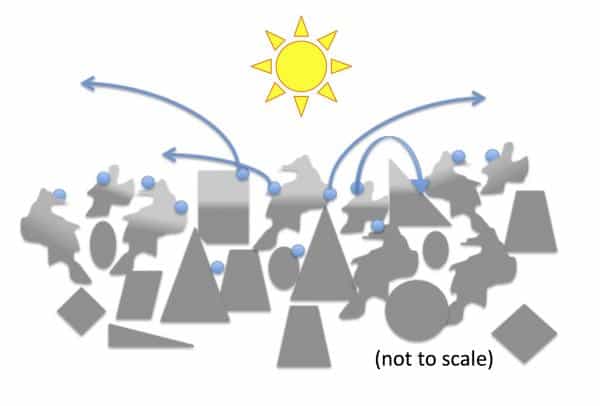Small amounts of water are attached to lunar grains on the dayside of the Moon and migrate around depending on surface temperature, as reported in a new paper by Planetary Science Institute Senior Scientist Amanda Hendrix.
Data from NASA’s Lunar Reconnaissance Orbiter (LRO) shows that lunar water molecules can adhere to surface grains at night and through much of the day, and migrate around when the temperature reaches its peak at mid-day, says a new paper in Geophysical Research Letters titled “Diurnally-Migrating Lunar Water: Evidence from Ultraviolet Data” on which Hendrix is lead author.
Data from the Lyman Alpha Mapping Project (LAMP) instrument aboard LRO are consistent with surface water on the Moon, varying with both terrain type and the local time and temperature, Hendrix said. LAMP is a far-ultraviolet (FUV) imaging spectrograph.
Data from the FUV spectrograph are used to measure the signature of a partial monolayer of water on the top surface of the lunar regolith. The diurnally‐varying signature is interpreted as water molecules thermally desorbing close to local noon each day, when the surface temperature reaches a maximum value. These measurements represent the first time the UV absorption signature has been used to detect water at low latitudes on a rocky airless body, and are the only set of data currently providing diurnal coverage of lunar hydration.
“Variations in FUV spectra are attributed to a partial monolayer of water thermally absorbing and desorbing, controlled mainly by temperature,” Hendrix said. “Lunar highlands regions are more hydrated than mare regions, likely due to the greater numbers of activation sites on the grains – these are locations on the lunar grains that can really hold on tightly to a water molecule.”
A major source of water on the Moon is considered to be protons (hydrogen ions) in the solar wind. When the Moon passes through the magnetotail of the Earth – a region where the Moon is shielded from the solar wind – it is expected that this source of water essentially turns off. However, the new results show that the water observed by LAMP does not change when the Moon is in the magnetotail, suggesting that the water observed by LAMP is not being produced immediately by the solar wind, but rather builds up over time.
“These results aid in understanding the lunar water cycle and will ultimately help us learn about accessibility of water that can be used by humans in future missions to the Moon,” Hendrix said. “A source of water on the Moon could help make future crewed missions more sustainable and affordable. Lunar water can potentially be used by humans to make fuel or to use for radiation shielding or thermal management; if these materials do not need to be launched from Earth, that makes these future missions more affordable.
“But first we need to understand more about where the lunar water is and how accessible it is,” Hendrix said. “We know that there is water frost in the permanently shadowed regions near the lunar poles. Does the water that LAMP observes at lower latitudes on the Moon bounce around and eventually make it to the cold polar regions?”
“This is an important new result about lunar water, a hot topic as our nation’s space program returns a focus on lunar exploration,” said Southwest Research Institute’s Kurt Retherford, the principal investigator of the LRO LAMP instrument. “We recently converted the LAMP’s light collection mode to measure reflected signals on the lunar dayside with more precision, allowing us to track more accurately where the water is and how much is present.”
PSI Senior Scientist Faith Vilas is a co-author on the paper.
Funding for the project came from a LRO LAMP subcontract between SwRI and PSI and wasalso supported by a NASA Solar System Exploration Research Virtual Institute (SSERVI) cooperative agreement to PSI for the TREX node.
Reference: ”Diurnally-Migrating Lunar Water: Evidence from Ultraviolet Data,” Amanda Hendrix et al., 2019 Feb. 21, Geophysical Research Letters [https://doi.org/10.1029/2018GL081821].
Media Contact
Alan Fischer
Public Information Officer
520-382-0411
[email protected]
Science Contact
Amanda Hendrix
Senior Scientist
310-922-3414
[email protected]
Related Paper
Authors: A. R. Hendrix, D. M. Hurley, W. M. Farrell, B. T. Greenhagen, P. O. Hayne, K. D. Retherford, F. Vilas, J. T. S. Cahill, M. J. Poston, Y. Liu.
Journal: Geophysical Research Letters
Published: February 21, 2019
DOI: 10.1029/2018GL081821
Ref: Hendrix, A. R., et al. “Diurnally migrating lunar water: evidence from ultraviolet data.” Geophysical Research Letters 46.5 (2019): 2417-2424.

